In the years leading up to writing my novel Bearer of Bad News, I found myself intrigued by contemporary news stories involving valuables looted during World War II, from unlikely thrift store finds to international legal battles. I had moved to the Hague from San Francisco to work on a policy for the treatment of child victims and witnesses at the International Criminal Court, where I later worked as a Trial Lawyer, so international criminal law issues were of particular interest to me. I found myself increasingly thinking about title to such items, especially when—as the old saying goes—possession is nine-tenths of the law.
Article continues after advertisement
But possessing something is different than being able to sell it, and the sale of a rare and easily identifiable object draws attention. This might explain why some such items end up donated anonymously to thrift stores. In 2018, a Texas antiques dealer found a 2,000-year-old Roman bust on sale in her local goodwill store for $34.99. Experts later determined that the 52-pound marble head had disappeared from Germany after Allied bombing in World War II, likely stolen by an American G.I.
For an undisclosed finder’s fee, the dealer returned the bust to Germany. In a Queens Habitat for Humanity thrift store in 2019, a man paid less than $80 for what turned out to be an original drawing by famed Austrian artist, Egon Schiele, worth an estimated $200,000. Unlike the bust, with an established provenance in Germany, there is no way to know whether the Schiele drawing was stolen or brought to the U.S. legally.
Most of us would agree that certain physical objects, because they are key to a memory or experience or perhaps because they were beloved by a loved one, are priceless.
The interesting thing to me about these thrift store finds is that the donors may have found the item after a relative’s passing and had no idea what they possessed…or they may have known exactly what they had and chose the donation route to avoid uncomfortable questions. Others, like the Meador family, had no problem with uncomfortable questions. After the death of U.S. Army Lieutenant Joe T. Meador, who stole priceless church artifacts from Quedlinburg, Germany, his family sold some of the stolen goods to a German art repatriation organization for $3 million in 1990. Criminal charges against the family were dismissed because of the expired statute of limitations, and an IRS suit for $50 million ended in a settlement for a paltry $135,000 in 2000.
From the Romans to the Vikings, looting was an inherent part of ancient conflict and often a component of what soldiers regarded as their compensation. But long before World War II, pillaging was viewed as unacceptable and was explicitly banned in the Lieber Code of 1863, which concerned rules of military conduct during the U.S. Civil War. The Lieber Code became one of the precedents of modern international criminal law, which is based on both customary law and treaties from hundreds of years of conflicts. There is no question that it was a war crime both for Nazis to steal artwork and for Allied soldiers to steal artifacts during World War II, whether from a person, a museum or an abandoned house.
Of course, even if there is a law against something, that doesn’t mean it will be prosecuted, or prosecuted successfully. That was the case with notorious looter Bruno Lohse, subject of the recent PBS documentary “Plunderer: The Life and Times of a Nazi Art Thief,” who was acquitted by a military tribunal in Paris in 1950 and went on to seek the return of artworks confiscated from him—in some cases, successfully—and returned to post-war life as an art dealer in Munich. He died without facing any serious consequences for his actions, and upon his death, a secret bank vault in Switzerland was found with paintings of indeterminate provenance from artists as renowned as Renoir and Monet as well as a Camille Pissarro painting known to have been stolen by the Gestapo in 1938 from a Jewish publisher in Vienna.
In many cases, there isn’t a clear villain like Lohse—it’s not always known if something was stolen from—as opposed to sold by—the previous owner, and if it was sold, whether the sale was voluntary or under duress. Even for valuables that were clearly stolen, the item may have switched ownership multiple times since, with the current owners completely unaware of the original theft. Sometimes when the provenance is revealed, unsuspecting owners do the right thing. In 2023, a Houston art gallery listed a Monet pastel that had been seized by the Nazis from the Parlagi family in 1940. When the current owners, Kevin Schlamp and Bridget Vita-Schlamp, were told, they voluntarily gave up the pastel, which was returned to the heirs of the original owners.
Other cases have been fiercely litigated in the courts. Just last year, a panel of the Ninth Circuit U.S. Court of Appeals ruled on the fate of yet another Pissarro painting—this one sold under duress by its previous owner Lilly Cassirer for a visa to leave Nazi Germany in 1939. The painting—Rue Saint-Honoré, in the Afternoon. Effect of Rain—was illegally brought to the U.S. and sold by a gallery in 1951, then sold again in 1976 and 1993, eventually ending up in a Spanish museum.
The decades-long legal case at various points involved U.S. courts applying Spanish law, the U.S. Supreme Court ordering the application of California law, and eventually a Ninth Circuit panel applying California law, which required the consideration of the conflict of law between California and Spain. The court ultimately ruled that the painting should remain in Spain, though a recently passed California law could reopen the case.
These are but a few examples from the rabbit hole I fell down while researching Bearer of Bad News. In the years to come, there will be more stories of thrift store finds and international legal battles: an estimated 100,000 artworks plundered during World War II remain missing, including priceless masterworks like Raphael’s Portrait of a Young Man. Some looted items, like jewelry where stones can be removed from settings, or objects made of precious metals that can be melted down, will never be recovered.
And, of course, many of the currently missing valuables were not looted during World War II. From museum heists to home invasions, the webpage for the FBI’s National Stolen Art File has forty-six pages of search results, while the Art Loss Register has more than 700,000 objects in its database. Items are as diverse as clocks, board games, rifles, and instruments in addition to art and jewelry, each with a story and an owner missing it enough to file a claim.
There are also larger conversations to be had about right to possession, such as present-day Nigeria’s call for the return of the Benin Bronzes, taken during a British raid on Benin City in 1897; the demand by Native American communities in the U.S. for the return of the remains of ancestors held in museums across the country; and numerous countries calling for the return of priceless treasures of cultural heritage currently in the possession of museums and private collectors.
This connection to a physical object that manifests culture, country, time and place is distinctly human. Nearly a million years ago, our ancestors homo erectus were already carving geometric patterns into shells found in Indonesia. By around forty thousand years ago, geometric symbols had progressed to human and animal figurines carved from mammoth ivory. Often these were left in graves, leaving no question as to their symbolic significance.
In today’s world, we have more possessions than ever, and certainly not all of them have such personal consequence (for example, I’d be devastated to lose my wedding ring, but less so the pair of earrings I found at a flea market and even less so my chapstick). But most of us would agree that certain physical objects, because they are key to a memory or experience or perhaps because they were beloved by a loved one, are priceless. Whatever the story that they evoke about our lives and our histories, the loss of this irreplaceable and singular connection is arguably the most painful wound left behind by theft.
The passage of time, which brings the death of rightful owners and those who remember what was taken and by whom, means that many of these wrongs may never be righted.
Claude Cassirer, Lilly’s grandson, remembered seeing the disputed Pissarro painting in his grandmother’s parlor as a child. In fact, the court files include a photo of the painting in situ in that parlor. In addition to being a masterful artwork, the painting is a physical link to a remembered place and time, part of his family’s story and collective memory such that its loss could only be assuaged by its return. Sadly Claude did not live to see that day. He filed the first lawsuit to reclaim the painting in 2005 but died several years later, leaving his son to continue what has now been nearly two decades of negotiations and legal wrangling.
All this to say, getting stolen valuables back to their rightful place is a painfully long process. Many organizations are doing good work to advance this cause, such as the Commission for Looted Art in Europe, the CIVS, and the World Jewish Restitution Organization, among others. The passage of time, which brings the death of rightful owners and those who remember what was taken and by whom, means that many of these wrongs may never be righted.
Perhaps that’s why in the refuge of fiction I created The Department of Lost Things, a mysterious quasi-governmental organization that could cut through bureaucratic red tape and conflicting national laws to thwart those who put greed above morality. In Bearer of Bad News, readers follow a Department of Lost Things case file that tracks a decades’ long search for an emerald necklace last seen eighty years ago, before the 1945 fall of Berlin to the Red Army. A Department of Lost Things operative is one of many seekers, including an unqualified and reluctantly enlisted Bearer of Bad News, who converge on a village in the Italian Dolomites where the necklace has been spotted.
I still wish there were a real organization where those of us so inclined could take a break from our day jobs and moonlight trying to right the world’s wrongs with an unlimited budget and cutting-edge technology and off-the-books secret agents at our disposal. While I may have invented the Department of Lost Things, this work is still possible if less glamorous—we can choose to spend some of our nights and weekends and vacations applying our talents and resources to the causes that make the world more just and each of us more human and less lost. Maybe even at your local charity shop, where you could be the next to encounter a priceless lost item waiting to be returned.
__________________________________

Bearer of Bad News by Elisabeth Dini is available from Gallery Books, an imprint of Simon & Schuster.
